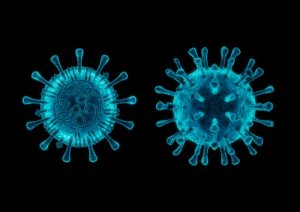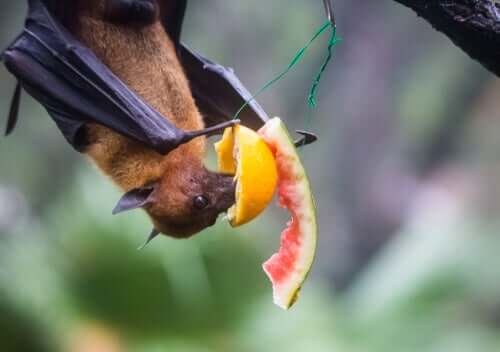5 Things You Should Know About Canine Coronavirus


Written and verified by biochemistry Luz Eduviges Thomas-Romero
We are in the midst of an explosion of news regarding coronavirus. So, you may be asking yourself what the new 2019-nC0V has to do with the canine coronavirus. Where does it come from? And above all, is my pet at risk? There are still many unanswered questions around the new outbreak. But we hope to calm some of your fears in the following article which contains 5 things you should know about canine coronavirus.
1. What are the coronaviruses?
Coronaviruses (CoV) consist of a family of approximately 40 viruses. These microorganisms get their name from the structure of their covering, which has a crown shape. In general, these viruses infect mammals in a species-specific manner. So, scientists have isolated specific strains of coronavirus that infect cats, rabbits, ferrets, cows, turkeys, and pigs.
Among these strains, there are three viral types that can infect dogs, which are known as canine coronaviruses. These are CCoV I, CCoV II y CRCoV. The “CC” in their names refers to “canine coronavirus or, in the case of “CRC”, it refers to canine respiratory coronavirus.

In humans, members of this family of viruses can cause the common cold. An estimated 15% of flu infections are from the coronavirus family. Other viral types cause more serious illnesses like Middle East respiratory syndrome (MERS-CoV) and severe acute respiratory syndrome (SARS-CoV). The virus that caused the outbreak that began in Wuhan is known as, provisionally “new”, 2019-nCoV.
The new coronavirus 2019-nCoV is a new strain of coronavirus that had not previously been present in human beings.
2. Can people and pets spread coronavirus to one another?
This is another question that many people have regarding canine coronavirus. Although dogs, cats, and humans can contract viruses that belong to the Coronaviridae family, infections are, in general, specific to each species. Therefore, the spread of infection from one species to another is rare.
However, it’s important to point out that viruses are well-known for their ability to mutate. Normally, viral mutants maintain their species specificity. This explains why, despite how long viruses have been present on the planet, they have not been able to do away with the human species.
Very occasionally, a mutation occurs that allows a virus to infect members of different species. For now, experts are not expressly concerned about the coronavirus infection spreading between humans, dogs, and cats.
Based on the analysis of changes induced by mutations if the sequences of the viruses, experts have demonstrated that the coronaviruses MERS-CoV and SARS-CoV and even 2019-nCoV originate in bats.
You may also want to read: Is the Pangolin Responsible for Transmitting Coronavirus COVID-19?

3. How serious is canine coronavirus infection?
Scientists are aware of three types of canine coronavirus. Two of them make up group I, cause diarrhea, and are very similar to one another. These are CCoV I and II, both of which cause mild symptoms and often go unnoticed.
The first report on CCoV infection appeared in the year 1974. This is when researchers isolated this virus strain in dogs with severe enteritis in a canine military unit in Germany.
In the year 2003, a third canine coronavirus was reported. CRCoV makes up group II and causes respiratory problems that can be serious. The infection causes pneumonia and can lead to the death of the animal. It has a high incidence in dogs that live in overcrowded conditions.
Reports have been made of outbreaks caused by a CRCoV that is highly virulent and pantropic, meaning it affects many organs. What’s more, the CRCoV, together with other viruses from different families that cause respiratory infections are known as kennel cough.
4. How frequent is canine coronavirus infection?
A variety of serological and virological studies demonstrate that CCoV is very widespread among the canine population. Particularly, the virus is highly prevalent in kennels and animal shelters.
Enteric infection by CCoV has a high morbidity rate (proportion of sick individuals) and a low mortality rate. The virus is eliminated in high concentrations in the saliva and feces of affected animals and spreads via the fecal-oral route.
In the case of group II, reports from the United States have estimated that 50% of evaluated dogs possess antibodies against CRCoV. This indicates that these animals were exposed to the virus earlier on in their lives.
5. Should I be worried about canine coronavirus?
No. In fact, there is a virus available against the group I coronaviruses. However, most veterinarians follow the indications of the World Small Animal Veterinary Association (WSAVA). As the infection is very slight, the association doesn’t recommend the vaccine.
There is no specific treatment for the infections that the pantropic CRCoV causes. Handling the infection should emphasize support treatment in order to maintain the proper balance of liquids and electrolytes. Veterinarians can also prescribe the administration of a broad spectrum of antimicrobial agents in order to treat secondary bacterial infections. However, it’s not common for specialists to recommend this course of treatment.
To date, there are no vaccines against the pantropic CRCoV. It’s been shown that the inactivated vaccines that are currently used against the enteric CCoV have very little effect. The best prevention is to vaccinate your dog against respiratory infections (the parainfluenza virus, adenovirus, distemper, and Bordetella bronchiseptica) in order to avoid coinfection. What’s more, you should isolate dogs with kennel cough until symptoms disappear.
We are in the midst of an explosion of news regarding coronavirus. So, you may be asking yourself what the new 2019-nC0V has to do with the canine coronavirus. Where does it come from? And above all, is my pet at risk? There are still many unanswered questions around the new outbreak. But we hope to calm some of your fears in the following article which contains 5 things you should know about canine coronavirus.
1. What are the coronaviruses?
Coronaviruses (CoV) consist of a family of approximately 40 viruses. These microorganisms get their name from the structure of their covering, which has a crown shape. In general, these viruses infect mammals in a species-specific manner. So, scientists have isolated specific strains of coronavirus that infect cats, rabbits, ferrets, cows, turkeys, and pigs.
Among these strains, there are three viral types that can infect dogs, which are known as canine coronaviruses. These are CCoV I, CCoV II y CRCoV. The “CC” in their names refers to “canine coronavirus or, in the case of “CRC”, it refers to canine respiratory coronavirus.

In humans, members of this family of viruses can cause the common cold. An estimated 15% of flu infections are from the coronavirus family. Other viral types cause more serious illnesses like Middle East respiratory syndrome (MERS-CoV) and severe acute respiratory syndrome (SARS-CoV). The virus that caused the outbreak that began in Wuhan is known as, provisionally “new”, 2019-nCoV.
The new coronavirus 2019-nCoV is a new strain of coronavirus that had not previously been present in human beings.
2. Can people and pets spread coronavirus to one another?
This is another question that many people have regarding canine coronavirus. Although dogs, cats, and humans can contract viruses that belong to the Coronaviridae family, infections are, in general, specific to each species. Therefore, the spread of infection from one species to another is rare.
However, it’s important to point out that viruses are well-known for their ability to mutate. Normally, viral mutants maintain their species specificity. This explains why, despite how long viruses have been present on the planet, they have not been able to do away with the human species.
Very occasionally, a mutation occurs that allows a virus to infect members of different species. For now, experts are not expressly concerned about the coronavirus infection spreading between humans, dogs, and cats.
Based on the analysis of changes induced by mutations if the sequences of the viruses, experts have demonstrated that the coronaviruses MERS-CoV and SARS-CoV and even 2019-nCoV originate in bats.
You may also want to read: Is the Pangolin Responsible for Transmitting Coronavirus COVID-19?

3. How serious is canine coronavirus infection?
Scientists are aware of three types of canine coronavirus. Two of them make up group I, cause diarrhea, and are very similar to one another. These are CCoV I and II, both of which cause mild symptoms and often go unnoticed.
The first report on CCoV infection appeared in the year 1974. This is when researchers isolated this virus strain in dogs with severe enteritis in a canine military unit in Germany.
In the year 2003, a third canine coronavirus was reported. CRCoV makes up group II and causes respiratory problems that can be serious. The infection causes pneumonia and can lead to the death of the animal. It has a high incidence in dogs that live in overcrowded conditions.
Reports have been made of outbreaks caused by a CRCoV that is highly virulent and pantropic, meaning it affects many organs. What’s more, the CRCoV, together with other viruses from different families that cause respiratory infections are known as kennel cough.
4. How frequent is canine coronavirus infection?
A variety of serological and virological studies demonstrate that CCoV is very widespread among the canine population. Particularly, the virus is highly prevalent in kennels and animal shelters.
Enteric infection by CCoV has a high morbidity rate (proportion of sick individuals) and a low mortality rate. The virus is eliminated in high concentrations in the saliva and feces of affected animals and spreads via the fecal-oral route.
In the case of group II, reports from the United States have estimated that 50% of evaluated dogs possess antibodies against CRCoV. This indicates that these animals were exposed to the virus earlier on in their lives.
5. Should I be worried about canine coronavirus?
No. In fact, there is a virus available against the group I coronaviruses. However, most veterinarians follow the indications of the World Small Animal Veterinary Association (WSAVA). As the infection is very slight, the association doesn’t recommend the vaccine.
There is no specific treatment for the infections that the pantropic CRCoV causes. Handling the infection should emphasize support treatment in order to maintain the proper balance of liquids and electrolytes. Veterinarians can also prescribe the administration of a broad spectrum of antimicrobial agents in order to treat secondary bacterial infections. However, it’s not common for specialists to recommend this course of treatment.
To date, there are no vaccines against the pantropic CRCoV. It’s been shown that the inactivated vaccines that are currently used against the enteric CCoV have very little effect. The best prevention is to vaccinate your dog against respiratory infections (the parainfluenza virus, adenovirus, distemper, and Bordetella bronchiseptica) in order to avoid coinfection. What’s more, you should isolate dogs with kennel cough until symptoms disappear.
All cited sources were thoroughly reviewed by our team to ensure their quality, reliability, currency, and validity. The bibliography of this article was considered reliable and of academic or scientific accuracy.
- Erles, K., Toomey, C., Brooks, H. W., & Brownlie, J. (2003). Detection of a group 2 coronavirus in dogs with canine infectious respiratory disease. Virology, 310(2), 216-223.
- Binn, L. N., Lazar, E. C., Keenan, K. P., Huxsoll, D. L., Marchwicki, R. H., & Strano, A. J. (1974). Recovery and characterization of a coronavirus from military dogs with diarrhea. In Proceedings of the Annual Meeting of the United States Animal Health Association, pp. 359–366.
- Day, M., Horzinek, M.C., Schultz, R.D., Squires R.A (2016) Directrices para la vacunación de perros y gatos de la asociación mundial de veterinarios de pequeños animales (WSAVA). Journal of Small Animal Practice • Vol 5, E20.
- Le Poder, S. (2011). Feline and canine coronaviruses: common genetic and pathobiological features. Advances in virology, 2011.
This text is provided for informational purposes only and does not replace consultation with a professional. If in doubt, consult your specialist.








